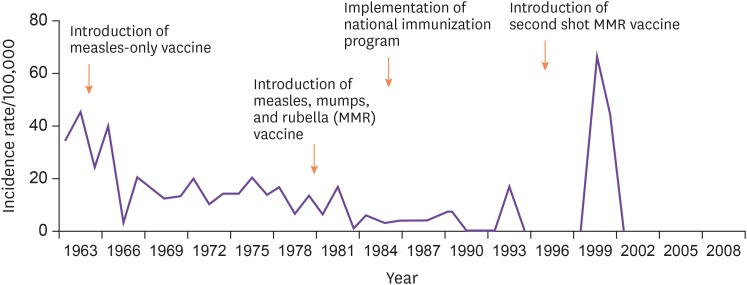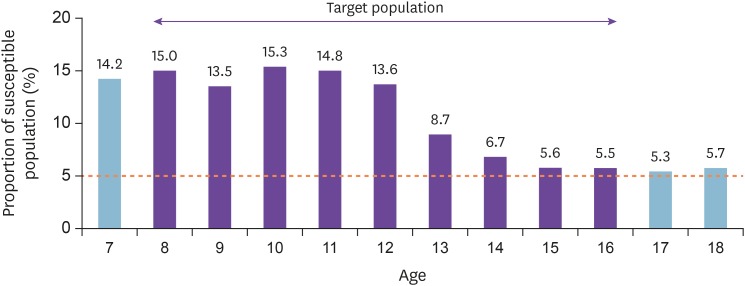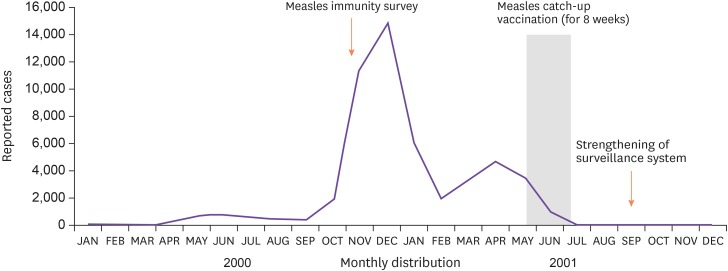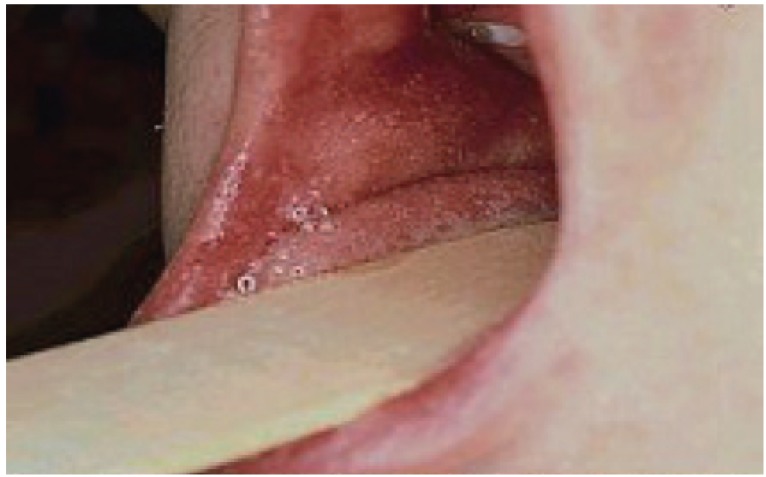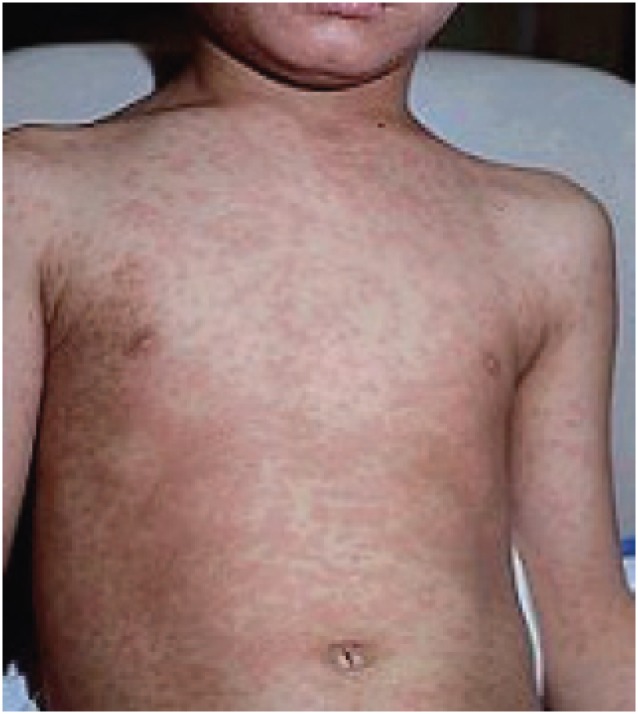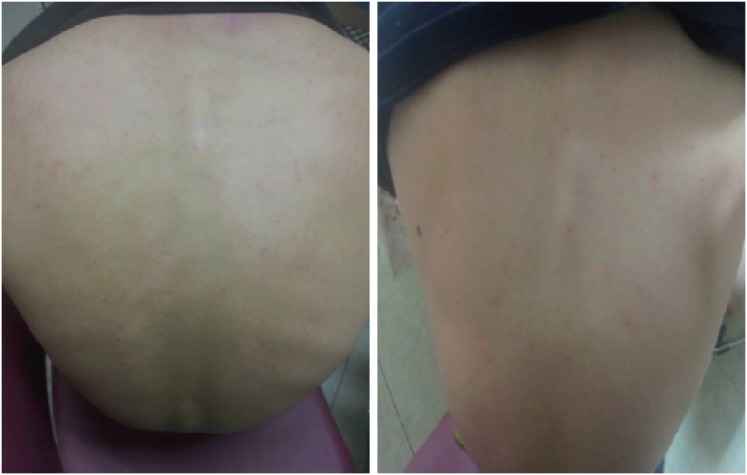Infect Chemother.
2020 Mar;52(1):113-122. 10.3947/ic.2020.52.1.113.
Review of Measles in Korea: Quarantine and Elimination
- Affiliations
-
- 1Department of Pediatrics, College of Medicine, The Catholic University of Korea, Seoul, Korea
- 2The Vaccine Bio Research Institute, College of Medicine, The Catholic University of Korea, Seoul, Korea
- KMID: 2507334
- DOI: http://doi.org/10.3947/ic.2020.52.1.113
Abstract
- Strong policies were established to maintain vaccination rate at ≥95% to expedite the eradication and elimination of measles outbreaks; nationwide survey of measles immunity to determine the susceptibility and the mandatory submission of second measles vaccination records when entering primary school. The measles control policies were also implemented to help achieve the goal of eliminating measles after the catch-up vaccination and they can be summarized as strategies for classifying measles patients based on their clinical symptoms while anticipating that weaker symptoms than those in typical cases would be seen; improving the operation of laboratories to world-class level for diagnosis of measles and identification of epidemiological circumstances for strengthen the detection of patients suspected of having measles; and immediate response through a rapid reporting system. With these efforts, Korea became the country to make the declaration of measles elimination by complying with all standards presented by the World Health Organization in 2006, re-verified in 2014. However, sporadic outbreaks of measles have repeatedly occurred even after the declaration of measles elimination. This indicates the need for continued control of imported cases and possible re-outbreaks. Also, it will be necessary to find and implement measures to continuously maintain the policy.
Keyword
Figure
Reference
-
1. <Q&A on Health> Measles: May is potentially the deadliest month; live attenuated measles vaccine provides life-long immunity. Chosun Ilbo. 1966. 5. 22. p. 5.2. Measles: The use of crayfish juice (folk medicine) is dangerous; keeping doors closed is not required for a patient. Chosun Ilbo. 1965. 5. 30. p. 5.3. Measles: An infectious disease that is active between seasons. Stay alert for the first 3 days. Chosun Ilbo. 1975. 3. 13. p. 5.4. <Home> Schedule and types of childhood immunization. The incidence of measles, mumps, and rubella is high in spring. Chosun Ilbo. 1978. 2. 23. p. 5.5. No vaccine is 100% effective against measles. “Vaccination failure” occurs in 31% of children. Chosun Ilbo. 1993. 11. 23. p. 19.6. Korea Centers for Disease Control and Prevention (KCDC). 2010 infectious diseases surveillance yearbook. Osong: KCDC;2011.7. Korea National Institute of Health (KNIH). 2001 Guidelines for measles mass vaccination campaign. Osong: KNIH;2001.8. Korea National Institute of Health (KNIH). Nationwide measles immunity survey report. Osong: KNIH;2002.9. Korea National Institute of Health (KNIH). Working manual on epidemiological survey of adverse reactions after vaccination. 2001. Available at: https://www.nih.go.kr/board.es?mid=a40303010000&bid=0015&act=view&list_no=7757&tag=&nPage=344.10. Measles vaccination was required for all the visitors from North Korea on the occasion of inter-Korea family reunions. JoonAng Ilbo. 2000. 11. 28. p. 2.11. Korea Centers for Disease Control and Prevention (KCDC). 2006 Measles surveillance & control guide. Available at: http://www.cdc.go.kr/board.es?mid=a20507020000&bid=0019&tag=&act=view&list_no=138502.12. Korea Centers for Disease Control and Prevention (KCDC). Measles Control Guide. 2014. Available at: https://www.cdc.go.kr/board/board.es?mid=a20507020000&bid=0019&act=view&list_no=138244&tag=&nPage=33.13. Korea Centers for Disease Control and Prevention (KCDC). Infectious disease control: Measles. Osong: KCDC;2014.14. Korea Centers for Disease Control and Prevention (KCDC). Epidemiology and prevention of vaccine-preventable diseases. Osong: KCDC;2011. p. 187–199. Available at: http://www.cdc.go.kr/board.es?mid=a20507020000&bid=0019&tag=&act=view&list_no=138334.15. National Institute of Health. 2003 Measles prevention and control. Available at: http://www.cdc.go.kr/board.es?mid=a40305010000&bid=0019&tag=&act=view&list_no=138541.16. Korea Centers for Disease Control and Prevention (KCDC). Press release. 2008. 3. 14.17. Korea Centers for Disease Control and Prevention (KCDC). Guidelines for infectious disease control and prevention. 2017. Available at: http://www.cdc.go.kr/CDC/cms/content/mobile/25/74925_view.html.
- Full Text Links
- Actions
-
Cited
- CITED
-
- Close
- Share
- Similar articles
-
- 2000~2001 result and lesson of the measles campaign for measles epidemic elimination
- Strategies for Minimizing Mealses Transmission in Korean Healthcare Facilities
- Current status of measles in the Republic of Korea: an overview of case-based and seroepidemiological surveillance scheme
- Assessment about the measles elimination from cases and outbreaks, 2002-2007: Assessment about the measles elimination
- Current and Prospect on Measles Outbreak

